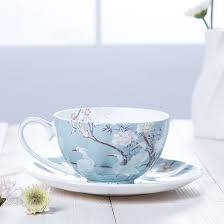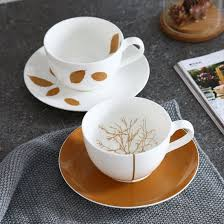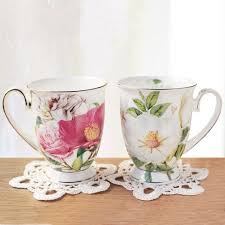When it comes to your ideal sipping situation, would you rather have your favorite beverage taste as good as possible or bland and flavorless? We bet the answer is pretty obvious.
An essential piece of achieving the best taste is the material the mug is made out of. While there are many different types of drinking vessels out there, from plastic to metal to paper, the material you choose will affect your coffee’s taste. Here’s why ceramic coffee mugs dominate the taste test and are much more superior to alternative materials.
Why does coffee taste better out of a ceramic mug? The first thing you should know about enjoying a beverage is that presentation plays a crucial role in how the drink tastes. There are plenty of studies out there that prove presentation helps dictate taste, and you’ve undoubtedly experienced it first-hand before. Anytime you go to the restaurant, the meal isn’t just plopped onto the plate in any-which-way. It’s carefully arranged and organized that better represents a high-quality and tasteful meal. Just as ceramic does for coffee.
The first thing you should know about enjoying a beverage is that presentation plays a crucial role in how the drink tastes. There are plenty of studies out there that prove presentation helps dictate taste, and you’ve undoubtedly experienced it first-hand before. Anytime you go to the restaurant, the meal isn’t just plopped onto the plate in any-which-way. It’s carefully arranged and organized that better represents a high-quality and tasteful meal. Just as ceramic does for coffee.
It’s human nature to perceive quality by context, and using a ceramic mug usually means you’re enjoying a more comfortable environment. Think about it in comparison with a paper cup. When drinking from ceramic coffee mugs, it feels like a better experience because of the associations you make to your mug, from the location you use it in (home, office, local coffee shop) to its weight, texture and insulating properties. On the other hand, a paper cup is temporary and disposable, most likely used in new environments or unique situations, like an out-of-state business meeting.
While the perceived taste quality is important, there’s also an objective improvement as well. For flavor, ceramic is the best choice. So, why does coffee taste better out of a ceramic mug? Because ceramic is a solid and neutral material, it neither absorbs nor imparts flavors, leaving coffee to taste just as it should. Our sense of taste is complicated, to say the least. For one thing, you can’t simply narrow down taste properties with only sweet, sour, salty and bitter. Much of what we consider flavor is really smell – so with its neutral characteristics, ceramic really is the best choice.
Other types of mug materials
There’s plenty of other types of mug materials, but why don’t they make coffee taste as good as ceramic? Let’s explore a few of the different types of mugs and what they’re made of.
PLASTICPlastic may seem like a good choice because of its light weight and convenience, however, overtime the material will actually absorb odors and flavors, causing your coffee to taste bad. It probably isn’t a big deal if you only drink one type of liquid from your plastic mug, however, even different types of coffee can be absorbed by the porous plastic and over time, make your beverages taste bad.
PAPERProbably the worst way to drink coffee is out of a paper cup. When you heat up paper, especially treated paper like what a Bone China Coffee Cups is made out of, it can start to smell. This will certainly disrupt an ideal drinking experience.
Additionally, not only does coffee taste better out of a ceramic mug, but it’s a much more sustainable way to enjoy your beverages.
STAINLESS STEELWhile stainless steel might be extremely durable, and good for outdoor excursions, it can impart flavors into your coffee. It won’t absorb flavor, but because many companies choose to use cheap materials, finishes can slowly wash away into the beverages. Plus, there are more than 1,000 compounds in coffee that can react oddly with metal, so you could receive some strange-tasting notes.
best handmade crystal glass brass casted cognac glasses
Blog
Bone China Coffee Cups
engraved coffee cup
Bone china is a type of porcelain that is composed of bone ash, feldspathic material, and kaolin. It has been defined as "ware with a translucent body" containing a minimum of 30% of phosphate derived from animal bone and calculated calcium phosphate.[1] Bone china is the strongest of the porcelain or china ceramics, having very high mechanical and physical strength and chip resistance, and is known for its high levels of whiteness and translucency.[2][3] Its high strength allows it to be produced in thinner cross-sections than other types of porcelain.[2] Like stoneware it is vitrified, but is translucent due to differing mineral properties.[4]
In the mid-18th century, English potters had not succeeded in making hard-paste porcelain (as made in East Asia and Meissen porcelain) but found bone ash a useful addition to their soft-paste porcelain mixtures, giving strength. This became standard at the Bow porcelain factory in London (operating from around 1747), and spread to some other English factories. The modern product was developed by the Staffordshire potter Josiah Spode in the early 1790s. Spode included kaolin, so his formula, sometimes called "Staffordshire bone-porcelain", was effectively hard-paste, but stronger, and versions were adopted by all the major English factories by around 1815.[5]
From its initial development and up to the latter part of the 20th century, bone china was almost exclusively an English product, with production being effectively localised in Stoke-on-Trent.[6] Most major English firms made or still make it, including Spode, and Worcester, Royal Crown Derby, Royal Doulton, and Wedgwood, Mintons. In the 20th century it began to be made elsewhere, especially in USSR, Leningrad (ЛФЗ), China and Japan, and China is now the world's largest manufacturer.
In the UK, references to "china" or "porcelain" can refer to bone china, and "English porcelain" has been used as a term for it, both in the UK and around the world.[7]
Contents1 History2 Production3 Production locations4 Cultural issues5 References6 External linksHistoryThe first development of what would become known as bone china was made by Thomas Frye at his Bow porcelain factory near Bow in East London in 1748. His factory was located very close to the cattle markets and slaughterhouses of London and Essex, and hence easy access to animal bones. Frye used up to 45% bone ash in his formulation to create what he called "fine porcelain".[6][8]
Plate from Ronald Reagan's state service for the White House, by LenoxLater, Josiah Spode in Stoke-on-Trent further developed the concept between 1789 and 1793, introducing his "Stoke China" in 1796. He died suddenly the year later, and his son Josiah II quickly rechristened the ware "Bone china".[9] Among his developments was to abandon Frye's procedure of calcining the bone together with some of the other raw body materials, instead calcining just the bone. Bone china quickly proved to be highly popular, leading to its production by other English pottery manufacturers.[10] Both Spode's formulation and his business were successful: his formulation of 6 parts bone ash, 4 parts china stone and 3.5 parts china clay, remains the basis for all bone china, and it was only in 2009 that his company, Spode, went into receivership before eventually being purchased by Portmeirion.[6][11]
ProductionThe production of bone china is similar to porcelain, except that more care is needed because of its lower plasticity and a narrower vitrification range. The traditional formulation for bone china is about 25% kaolin, 25% Cornish stone and 50% bone ash.[12] The bone ash that is used in bone china is made from cattle bones that have a lower iron content. These bones are crushed before being degelatinised and then calcined at up to 1250 °C to produce bone ash.[13] The ash is milled to a fine particle size.[14] The kaolin component of the body is needed to give the unfired body plasticity which allows articles to be shaped.[2] This mixture is then fired at around 1200 °C.[14] The raw materials for bone china are comparatively expensive, and the production is labour-intensive, which is why bone china maintains a luxury status and high pricing.[6]
Bone china consists of two crystalline phases, anorthite (CaAl2Si2O8) and β-tricalcium phosphate/whitlockite (Ca3(PO4)2) embedded in a substantial amount of glass.[15]
 Production locationsFor almost 200 years from its development bone china was almost exclusively produced in the UK. During the middle part of the 20th century manufacturers in other countries began production, with the first successful ones outside the UK being in Japan: Noritake, Nikko and Narumi.[16][17]
Production locationsFor almost 200 years from its development bone china was almost exclusively produced in the UK. During the middle part of the 20th century manufacturers in other countries began production, with the first successful ones outside the UK being in Japan: Noritake, Nikko and Narumi.[16][17]
In more recent years production in China has expanded considerably, and the country is now the biggest producer of bone china in the world. Other countries producing considerable amounts of bone china are Bangladesh, India, Indonesia, Iran[citation needed], Sri Lanka and Thailand.[16][17][18]
From the start of the first factory, Bengal Potteries, in 1964, bone china output from Indian factories had risen to 10,000 tonnes per year by 2009. [19] Rajasthan has become a hub for bone china in India, with production in the state totaling 16-17 tonnes per day.[20]
In Leningrad, USSR, the bone china recipe was invented independently, since it was not possible to get the finished recipe. The production of bone china at the Lomonosov Porcelain Factory (Leningradsky Farforovii Zavod - ЛФЗ (LFZ) (after the collapse of the USSR, the historical name IFZ was returned to it) began only in the 1960s. The recipe obtained by the plant’s specialists made it possible to create porcelain, the products from which were obtained thinner and whiter than English products from bone china. This was achieved thanks to the special regime of firing thin-walled products from bone china, and all formulation developers received USSR State Awards. Until now, ЛФЗ (ИФЗ) in Saint-Petersburg, Russia)] remains the only company in Russia that produces bone china products.
Lenox was the only major manufacturer of bone china in the United States[citation needed], and has supplied presidential services to the White House. It closed production in the US permanently in March 2020.
Contact: engraved coffee cup
best brass coffee cup
We love all kinds of coffee gadgets to make the perfect brew and take full advantage of your favorite coffee beans, but the best coffee drinking experience starts and ends with your choice of the mug. Coffee and tea mugs are an essential part of any kitchen and have various styles for different purposes. These are our top picks for various categories, updated for 2020. Read on for details on all the styles.
The Best Coffee Mugs:Best everyday mug: Crate & Barrel Hue MugBest travel mug: CamelBak Hot Cap Travel MugBest bone china mug: Royal Worcester Wrendale Designs MugBest porcelain mug: Snowe MugBest smart mug: Ember Smart Mug 2Best stoneware mug: Le Creuset MugBest tea mug: DavidsTea Nordic MugBest ceramic mug: W&P Porter MugBest insulated mug: Hydro Flask Travel Coffee MugBest glass mug: Zwilling Sorrento Coffee MugBest stainless steel mug: YETI Rambler MugFactors to ConsiderDeciding which type of coffee cups or mugs to buy can be daunting. Serving coffee for the family? Keep a set of quality everyday mugs on hand. Need to keep your drink warm the whole morning? Go with an insulated option or even a smart mug that’ll carry you through to lunchtime. Here are a few of the things we consider when choosing which coffee mug to buy.
Materials
 What is the best material to use for best brass coffee cup? It really depends on the situation. Insulated stainless steel mugs will go the farthest in the way of heat retention. Ceramic won’t retain flavors or smells, porcelain and bone china are the most sturdy, and glass looks sleek in any setting. Silicone sleeves or double-walled construction will help with both gripping and insulation.
What is the best material to use for best brass coffee cup? It really depends on the situation. Insulated stainless steel mugs will go the farthest in the way of heat retention. Ceramic won’t retain flavors or smells, porcelain and bone china are the most sturdy, and glass looks sleek in any setting. Silicone sleeves or double-walled construction will help with both gripping and insulation.
Volume
How much coffee do you really drink in a sitting? Typically coffee cups are around 12 ounces, with variable options of up to 30 ounces for the large travel mugs. If you tend to drink half and leave the rest while running around getting things done in the morning, opt for a smaller 11-ounce size. If you’re a regular two cup drinker and know you’ll be pouring a third before you’re out the door, try an oversized mug. If you drink iced coffee, odds are you’ll need a bigger cup to hold both the ice and the coffee itself.
Features
How is the mug constructed? What nifty add-ons do you need? If you need an airtight travel option, it’s CamelBak, or for steeping tea and removing the leaves, it’s DavidsTea. Also, keep a lookout for the washing instructions; some great mugs require more care for keeping them clean; others are dishwasher safe and good to go at all times.
Best Everyday Mug: Crate & Barrel Hue MugCrate and Barrel Hue Dark Gray Mugs
CREDIT: CRATE AND BARRELFrom hot coffee to mug cakes and everything in between, these mugs look great and do it all. They’re wide enough to house plenty of marshmallows on hot cocoa, lightweight, stackable, and the handle is the ideal size. The handcrafted and hand-glazed porcelain comes in 6 colors, so you can mix and match or grab a full set. And yea, they’re good to go in the dishwasher, microwave, and oven.
Best China Mug: Royal Worcesterroyal worcester mugs
CREDIT: AMAZONBone china is the most durable ceramic material. It’s dishwasher safe while still looking stately and can be used both everyday or reserved for special occasions. These mugs are arguably the cutest animal designs out there, a worthy gift for any season.
